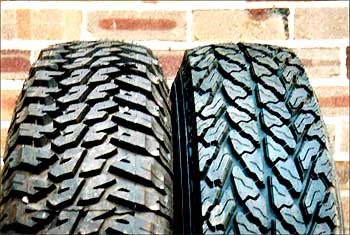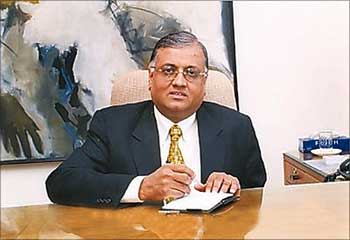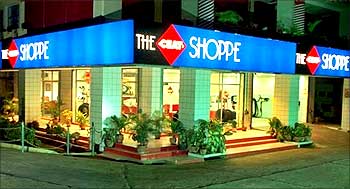Shyamal Majumdar in Mumbai
When Paras Chowdhary took over as the managing director of CEAT in 2001, he was thrilled to hear Chairman Harsh Goenka's assurance that he would get a free hand in running the company. But the caveat came swiftly: Chowdhary can ask for anything except money for additional investments.
It certainly wasn't music to his ears then, but the tyre industry veteran (Chowdhary was the CEO of Apollo Tyres for 11 out of the 22 years he spent there before joining the RPG Group) says he later understood Goenka's compulsions at that stage.
CEAT was for all practical purposes a sick company in 2001.
The Rs 14-crore (Rs 140-million) loss in that year was a lesser evil; what was particularly worrying was that the company was paying Rs 115 crore (Rs 1.15 billion)towards interest and depreciation. For a company with gross sales of just Rs 900 crore (Rs 9 billion), it was bad enough. Worse, both the loss as well as the interest amount were actually much more.
Here's why. CEAT then used to lend money to other group firms and charge interest on it which was considered as income.
But the interest never came and the entire amount had to be ultimately written off.
7 steps that helped CEAT turn around
Image: Paras Chowdhary.Analysts estimated the actual loss in 2000-01 at not less than Rs 60 crore (Rs 600 million) and the interest and depreciation at Rs 140 crore (Rs 1.4 billion).
Chowdhary admits CEAT's identity was blurred at that stage -- was it a tyre company or was it an investment company? "We were postponing our problems to the future. There were too many problems that were not immediately visible on the balance sheet," he says, sitting in his modest second-floor office at the RPG Group headquarters in Worli, Mumbai.
So, in 2001, the problem looked quite complicated: CEAT was over-leveraged, it had no money to spend, no financial institution was willing to support it, and raising money through the equity route was just not possible as the share price at that time was too low.
There was more. No supplier was willing to give material unless the company cleared the dues of over Rs 150 crore (Rs 1.5 billion). And it was getting increasingly difficult to explain to the investing community and the board the reasons for the worsening profit margin vis- -vis its competitors.
Then there were legacy issues. Both its plants were in Maharashtra -- one in Bhandup, a Mumbai suburb where the cost of operation was very high, and the other at Nashik.
To ship its produce outside the state, the company had to pay huge octroi -- a cost which its competitors who were well spread out weren't incurring. The factories were very old with practically no modernisation efforts.
And since it was not a leader in the business, CEAT had to price its products 2 to 3 per cent lower than rivals.
Analysts say CEAT's margins were hence around 5 per cent lower than competition. "In an industry where the profit margin has been traditionally low at 6 to 7 per cent, you had it if your margin is 5 per cent lower than competition," admits Chowdhary. The company's relatively smaller size only added to the problems.
7 steps that helped CEAT turn around
Image: A car mechanic at work.The fightback
Chowdhary had joined the RPG Group in 1997 but was heading the IT and telecom business for a peculiar reason: He had worked for Apollo long enough and didn't want to work for a rival tyre company. But in 2001, Goenka told him that CEAT 'was in a difficult spot' and it would be great if he could take charge.
Chowdhary knew that there were no easy answers to the problems that CEAT faced: He couldn't change the location of the factories, he didn't have the power to abolish octroi, he couldn't change the fact that Mumbai was a high cost city, he didn't have control over the fact that CEAT was an old company of 1960 vintage and hence carried a lot of baggage, and, most important, he couldn't find any money to ride out of the crisis.
Despite these handicaps, CEAT's transformation is an eye-opener. Consider the numbers first. The company's interest burden in 2008-09 was Rs 91 crore (Rs 910 million) -- less than 4 per cent of its net sales of Rs 2,500 crore. (Rs 25 billion)
In 2001, when he took charge, it was 13 per cent of a relatively smaller base of net sales. Chowdhary is now aiming to bring that number down to 3 per cent, despite higher capital expenditure.
CEAT's operating profit before tax as a percentage of net sales has gone up to 13.5 per cent in the first quarter of 2009-10 from (-) 1.7 per cent in the year-ago period. Compare this with the corresponding figures of market leaders Apollo (12.1 per cent from 6.9 per cent) and JK (from 4 per cent to 6.9 per cent) and one starts getting a sense of the dramatic transformation.
Productivity in CEAT's two factories has gone up by nearly 50 per cent since 2001 without much reduction in manpower.
Chowdhary is candid enough to admit that all this has been possible partly due to luck but mostly because of some 'real hard work' put in by his team members to implement a seven-fold turnaround strategy.
The fightback
Image: A CEAT showroomThe turnaround
The first part of the strategy of course was to reduce the debt burden and thereby cut the interest payout. CEAT stopped all fresh investments as it was desperate to clean up its books. Result: CEAT has been repaying Rs 80 crore (Rs 800 million) debt every year. Its total debt, including working capital loans, is now just Rs 398 crore (Rs 3.98 billion).
Two, it decided to get into high-margin segments (90 per cent of its products are now in that category) with a vengeance. That explains Chowdhary's drive to focus on the replacement market where the company's share in its total sales was just 50 per cent.
That figure went up to 75 per cent in the first quarter of 2009-10 -- something Chowdhary says was a dream fulfilled.
The replacement market is important for tyre manufacturers as the consumers here don't mind paying extra for a quality product.
But the fact is CEAT is the smallest player in radial tyres now with a monthly capacity of just 60,000 tyres against an average 200,000 of a couple of its competitors.
To correct this, CEAT is setting up a grassroots radial plant at Halol in Gujarat at an investment of Rs 500 crore or Rs 5 billion (half of that money will come from internal accruals).
The plant, which will start production from August next year three months ahead of schedule, will have a monthly capacity to produce 180,000 tyres, taking its monthly production of radial tyres to 240,000.
7 steps that helped CEAT turn around
Image: A CEAT office.Three, the company will start another plant at Ambarnath in Maharashtra by 2012, for which it has already been allotted 50 acres of land.
Four, it decided to get higher output from the two existing factories without making much investment. It was a difficult strategy to implement, but Chowdhary managed it by signing a long-term wage settlement with workers that was linked to productivity.
A few anxious moments later, the Bhandup plant production went up almost 50 per cent. In the Nashik plant, production went up as much as 70 per cent.
"The extent of the productivity increase surprised me. Money is a great motivator and the capacity of human beings to deliver is infinite," Chowdhary says. The workers made sure that plants were open even on Sundays.
Five, the company put its might behind ensuring the quality of the products. Earlier, the quality of its products was acceptable, but not something that would create a customer pull.
This was even more so as CEAT started targeting 20 per cent of its revenues from the export market where profitability was good.
Six, Chowdhary made cost-cutting a religion for CEAT. So things such as better working capital management, manpower rationalisation, reduction of administrative cost, cutting the commissions of the cost & forwarding agents became the new buzzwords.
"For a Rs 2,500-crore company, we were even willing to question practices that could save us just Rs 25,000 annually," Chowdhary says.
The cost of manpower will come down further once the Halol plant goes on stream because the salary of an industrial worker in Gujarat is at least 40 per cent lower than his counterpart in Maharashtra where CEAT's two plants are now located.
And seven, Chowdhary's top team resorted to some smart buying of raw materials. For example, it imported 20,000 tonnes of natural buyer valued at Rs 200 crore (Rs 2 billion) in February/March on a staggered shipment basis.
That gave it a 20 per cent cost advantage. Throughout the first and second quarter of this financial year, CEAT consumed natural rubber that was bought at Rs 75-80 at a time when the ruling market price of the raw material has been hovering around Rs 90-108 for the last three-four months.
7 steps that helped CEAT turn around
Image: A CEAT ad.Photographs: Courtesy, CEAT website
Eye on the future
Chowdhary says CEAT now wants to grow at 20 per cent per annum against the industry average of 13-14 per cent. And he is hopeful that the market share, which is at 14 per cent now, will increase to 20 per cent even on an expanded market in five to six years.
If that happens, CEAT hopes to improve its position to become the third largest tyre company in India from fourth now.
He also expects turnover to hit Rs 5,000 crore (Rs 50 billion) in FY 12 compared to an expected Rs 3,000 crore in this financial year. That's easily achievable as the Gujarat plant alone is expected to contribute over Rs 1,000 crore (Rs 10 billion) in 2011-12.
Competitors however are not losing any sleep. Say the chief executive of a rival tyre company: "CEAT is doing better now, but that's just not enough." He adds the size of the company is too small compared to MRF, Apollo and even JK.
Besides, CEAT, he says, has lacked a killer instinct and has been traditionally slow in responding to market requirements.
The problems of the past are also difficult to correct, he says.
Chowdhary is aware of the problems. "It's true all the problems have not been corrected, but we have made good progress," he says. That is reason enough for him to leave office at 6 pm every day as he has put together a capable team that can steer the company even in his absence.
Goenka would nod in approval.








article